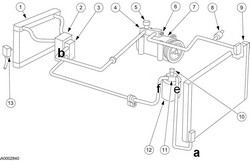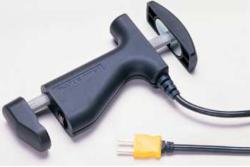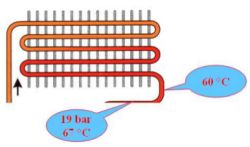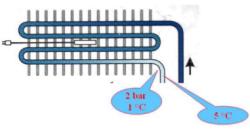Welcome to
An Automobile Diagnosis Website
Pressurized! Air Conditioning system with an Expansion Valve
Pressurized!
FAILURE TO FOLLOW SAFETY INSTRUCTIONS MAY RESULT IN PERSONAL INJURY.
Automotive air conditioners operate under high pressures and use refrigerants that
can be dangerous if improperly handled. Service and repairs should be performed
only by properly trained persons who understand refrigeration systems and their
operation. They must have access to specialized service tools and equipment, and
follow approved safety precautions. Additionally, any HVAC system refrigerant
recovery repairs require special licensing.
• Always wear eye protection when working on the refrigerant loop. If
refrigerant contacts your eye it may freeze, possibly causing an injury.
• Refrigerant can quickly cause frostbite. Avoid skin contact with refrigerant.
Always wear gloves when working with refrigerant.
• Work in a well ventilated area. Since refrigerant evaporates quickly, breathing
may become difficult due to lack of oxygen in poorly ventilated areas.
• Keep refrigerant away from open flame. Poisonous gas is produced when R-12
refrigerant burns.
• Never heat liquid refrigerant above 104°F (40°C) as this may cause the container to
explode. Never apply direct flame to a refrigerant container.
• Keep refrigerant containers stored below 104°F (40°C).
• Never release refrigerant directly into the atmosphere. It's a federal law with
fines and imprisonment for anyone releasing refrigerant into the atmosphere.
Always use approved recovery, recycling and charging equipment.
• Never mix R-134a and R-12 or their refrigerant oils. Results will range from
poor A/C system performance to expensive component and equipment
damage.
• There are many different Federal, state, and local ordinances to control the use
of refrigerants and their release into the atmosphere. Make sure you comply
with these ordinances, including training and certification.

Repair shop buss:
AC service: Cooling- and Overheating grade
Calculating the temperature difference between Cooling (10)Pressure/theoretical temperature, (a)real temperature and
the Overheating grade (5)Pressure/theoretical temperature, (b)real temperature, is a worthy way of
diagnosing power/efficiency of an A/C system. These temperatures (cooling/overheating) are
thus measured at the out-let lines of the evaporator and condenser (Pic.1). The temperature
difference will give the mechanic, with the related pressure readings of the low and high side, a relative
secure first clue where the problems lay.

Use a precise spot temperature sensor embedded in a pipe clamp or an infra-red temperature scanner.

Cooling Grade:
The Cooling grade is the difference between the theoretical temperature of the refrigerant to its
pressure on the high side (see gauge scale (°C,°F)), and the real temperature (precisely measured) of the
refrigerant measured at the condenser's
out-let.
For instance, a high side pressure of 19bar is equal to 67°C (theoretical temperature),
and a condenser out-let (real) temperature of 60°C, cooling grade value is 67°C - 60°C = 7°C,
considered optimal.
•Is the cooling grade temperature to low (example: 68°C - 66°C = 2°C), not enough refrigerant
in the condenser.
•Is the cooling grade temperature to high (example: 68°C - 56°C = 12°C), to much refrigerant
in the condenser.

Overheated grade:
The Overheated grade is the difference between the theoretical temperature of the refrigerant to the
related pressure on the low pressure side (see gauge scale (°C,°F)), and the real temperature (precisely measured) at the
evaporator's out-let.
•A good Overheating grade value lays between 2°C - 10°C.
•If you measure a pressure of 2 bar (= 1°C) on the low pressure side, and an evaporator out-let real temperature of
5°C, gives us an overheated grade value of 5°C - 1°C = 4°C, considered optimal.
•Is the Overheated grade value to high (example: 14°C - 0°C = 14°C), the refrigerant gets warm to fast, there is
not enough refrigerant in the evaporator.
•Is the Overheated grade value to low (example: 1°C - 0°C = 1°C), the refrigerant doesn't have enough
time to warm-up, there is to much refrigerant in the evaporator.
•A lower cooling grade value and/or a high overheated grade value, with higher temperature
blower air in the interior, are signs of refrigerant lack.
•A lower Overheating grade value and/or a higher cooling grade value, are sign of to
much refrigerant.
•A normal Overheated grade value and a higher cooling grade value are signs of a
dryer bottle restriction.
An air conditioning system with an expansion valve, that has a dryer/receiver bottle restriction,
imposes a resistance to the refrigerant. Through the occurring pressure difference between In-let and
Out-let, a premature expansion of the refrigerant takes place.
•A dryer/receiver bottle restriction can easily be diagnosed, through temperature measuring, is there a
temperature difference between In-let/Out-let, replace the bottle.

